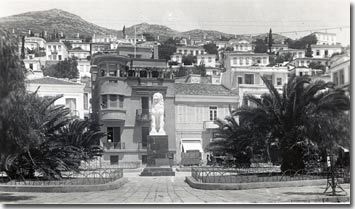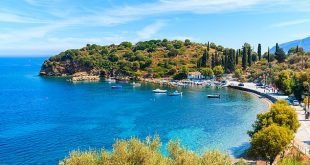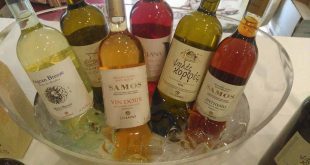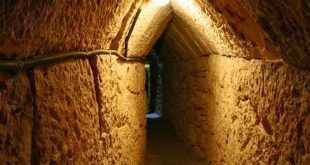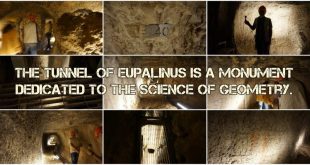Pythagoras Square and the Lion
Pythagoras Square, located in the city of Samos, was at the epicenter of the city’s reconstruction process, which followed the two devastating fires of 1871, both of which turned the surrounding neighborhoods into ashes.
Square’s fashioning began in 1864 under the planning and supervision of the French engineer Bouchet, while in 1882 it was named “Pythagoras Square”. In fact, the construction and the embellishment of Pythagoras Square was the first serious public work ever made, at that point, in the city of Samos.
At first it was constructed a kind of fountain and a garden. But later on, long before the construction of the Lion, a bronze fountain was placed, which was imported from England in 1876. The upper part of the square was paved with stones and running water was channeled to the fountain, while, from time to time, more alluviums were made.
An Eiffel Tower copy in Pythagoras Square
Later on an Eiffel Tower look like Tower Clock, which was imported from France, was erected at the center of Pythagoras Square, but it was dissolved quickly following the ironic comment of the local population.
Junta’s “Ritsa”
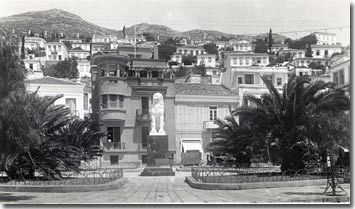 Other efforts of beautification were also received with similar comments or reactions. One such occasion was the placement of the lion in 1921, upon the centenary of the Greek War of Independence (1821). Another occasion was the placement, in 1968, of a copy of the American Statue of Liberty, the “Ritsa” as it was called or rather mocked by the people of Samos. “Ritsa” was a brass made statue, which was erected by the dictatorship appointed officials and remained in place until the fall of the military junta in Greece (1967-1974).
Other efforts of beautification were also received with similar comments or reactions. One such occasion was the placement of the lion in 1921, upon the centenary of the Greek War of Independence (1821). Another occasion was the placement, in 1968, of a copy of the American Statue of Liberty, the “Ritsa” as it was called or rather mocked by the people of Samos. “Ritsa” was a brass made statue, which was erected by the dictatorship appointed officials and remained in place until the fall of the military junta in Greece (1967-1974).
During the same period of time, the statue of Lion was moved next to the Town Hall. After the restoration of democracy in Greece (1974), the Lion, which was seen as a predominant feature of Pythagoras Square for the last 60 years, was returned to its original place.
The history behind the Lion of Pythagoras Square
What do we really know about the “Lion” of Samos, which stands imperious for so many years and look towards us showing his teeth, and if he could roar, he would have done so many times?
As mentioned above the Lion was placed in Pythagoras Square upon the centenary of the Greek War of Independence.
The idea to celebrate in greatness the centenary of the Greek War of Independence belonged to the well-known historian Spyridon Labros and it was proposed, for the first time, in 1899.
Spyridon Labros imagined “Eleftheria” celebrations as an expression of gratitude towards the heroes of 1821. This gratitude would have been expressed twofold. First, a number of statues would have been erected, a Pan-Hellenic Memorial, along with the construction of a “Grove of Heroes” in the garden of Zappeion Megaron (Athens) and secondly, all Greeks were welcomed to undertake a so-called “National Work”, i.e. something, anything that could, would or should add to the progress and greatness of the motherland.
The aim of the celebrations, which was defined in accordance with the proposals made by Spyridon Lambros, was twofold. First, to express the nation’s gratitude towards those who have fought or contributed to the 1821 Greek War of Independence and secondly, to show the progress made in Greece during the 100 years that followed independence.
In Samos a local, 14-member strong, committee, under the presidency of E. Athanasiadis (the Governor of Samos Prefecture) and Metropolitan Irenaios (as honorary president of the committee) took care of Samos’s participation in the Pan-Hellenic celebrations that took place in Athens, while, at the same time, organized celebration in Vathi port, which took place on August 6th, 1921, the same day of Mycale’s Naval Battle (August 6, 1824). The following day similar celebrations took place in Karlovasi.
Admittedly, these celebrations were quite successful in a way that allowed Samos to show its level of civilization and culture. Central to celebrations, in Vathi port, was the unveiling of the Memorial of Heroes (the lion) in Pythagoras Square, which was constructed due to whip rounds all over Samos Island. The memorial is a copy of the lion statue, placed at Chaeronea, after the Battle of Chaeronea in 338 BC.
It should be noted that at the time the erection of local memorials was responsibility of a special purpose committee. Its mover, Socrates Kougeas, wrote a report, in October 1918, in which he proposed various locations around Greece, where memorials (statues or others of symbolic meaning) could be erected or constructed.
The local committee of Samos decided to erect a memorial of symbolic meaning and tasked Basil Theophanides, its representative in Athens, to find the appropriate one. After he consulted with the French archaeologist Gilliéron as well as Greek archaeologists, he decided that the memorial should include a lion’s depiction.
The sculptor of the Lion
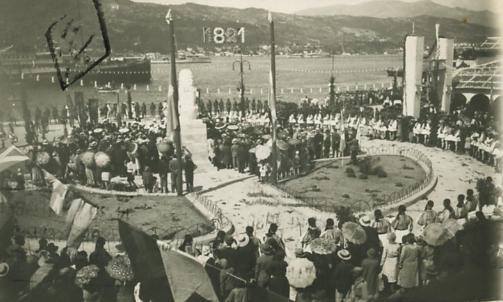 There were three sculptors who expressed interest to build the Lion (Nikos Dimitriades, Andreas Panagiotakis, and Ioannis Koulouris). All of them presented their proposals to the committee, which unanimously selected the one made by Ioannis Koulouris, while, later on, the Town Council of Vathi Port town agreed on and ratified the committee’s decision.
There were three sculptors who expressed interest to build the Lion (Nikos Dimitriades, Andreas Panagiotakis, and Ioannis Koulouris). All of them presented their proposals to the committee, which unanimously selected the one made by Ioannis Koulouris, while, later on, the Town Council of Vathi Port town agreed on and ratified the committee’s decision.
Vasilios Theophanides and the Professor of Archaeology, G. Oikonomou, supervised the sculpture during its construction. The 2,5 meters high “Lion” is made of white Pentelic marble and, since 15 July 1930, is placed on a 2,75 meters high pedestal made of blue marble (the pedestal was designed by Ioannis Koulouris and it was carved by a local stonemason).
We must also mention that Pythagoras Square was unanimously selected, by the Town Council, as the place where the Lion should by placed (a proposal to place the Lion in front of the Church of Transfiguration of Christ in the city of Tigani, nowadays Pythagoreion, was also examined but rejected).
Reactions from the opposition
 When the committee announced its final decision (i.e. the adoption of a lion’s depiction), the opposition press began to challenge and criticize the decision. In particular, according to academic history books and other references, “Samos” newspaper attacked the “beast”, as it used to call the memorial, while called the decision “feet folly”, “anachronistic” and a result of “xenophilia”. At the same time, published numerous letter written by citizens (called the “Lion-Opposers”), who called the sculpture “brutal work”, “coarse misspelling” and other names. The main critic was based on the following argument or perception: The 14-member committee had to form a wider committee consisting of “pure Samians” and not to consult with professors and artists, French and Greek. Moreover, the opposition side considered the committee’s decision as a gesture of contempt towards the Samian heroes who participated in the 1821 Greek War of Independence, the statues of which had to be erected, along with the statue of Likourgos Logothetis. From the opposion point of view the Lion of Chaeronea would eventually come to symbolize the bravery of the Sacred Band of Thebes, not the bravery of the Samian revolutionaries, because, according to the opposition, this symbolic memorial would be nothing more than “a reconstruction of phantasy for the intelligentsia, but not for the illiterate”.
When the committee announced its final decision (i.e. the adoption of a lion’s depiction), the opposition press began to challenge and criticize the decision. In particular, according to academic history books and other references, “Samos” newspaper attacked the “beast”, as it used to call the memorial, while called the decision “feet folly”, “anachronistic” and a result of “xenophilia”. At the same time, published numerous letter written by citizens (called the “Lion-Opposers”), who called the sculpture “brutal work”, “coarse misspelling” and other names. The main critic was based on the following argument or perception: The 14-member committee had to form a wider committee consisting of “pure Samians” and not to consult with professors and artists, French and Greek. Moreover, the opposition side considered the committee’s decision as a gesture of contempt towards the Samian heroes who participated in the 1821 Greek War of Independence, the statues of which had to be erected, along with the statue of Likourgos Logothetis. From the opposion point of view the Lion of Chaeronea would eventually come to symbolize the bravery of the Sacred Band of Thebes, not the bravery of the Samian revolutionaries, because, according to the opposition, this symbolic memorial would be nothing more than “a reconstruction of phantasy for the intelligentsia, but not for the illiterate”.
On the other hand, “Aigeon” newspaper strongly supported the committee’s decision. Because “Samos” newspaper published, on a daily basis, articles with ironic or even insulting expressions against the committee as a whole and especially against its member and mayor of Vathi Port Town, George Soutos, “Aigeon” newspaper published an article, titled “For the critics of Chaeronea’s Lion”, written by V. Theophanides. In order to defend the committee’s decision, Theophanides argued that he just “heard the advice of art”. The statue of Logothetis, the real physiognomy of which was not known for sure, would have cost tenfold, in financial terms. Besides, if Logothetis was to be honored with a statue of his own, other heroes, like Captain Lahanas, Captain Stamatis etc., would also have to be honored likewise. Many others, from mainland Greece, co-operated with Samians so, in the mind of Theophanides, a lion’s depiction would indeed reflect “the overall Pan-Hellenic momentum and ardent patriotism”, while “the Lion of Chaeronea will teach generations to come without limitations in terms of place or time”.
From his point, mayor Soutos, who faced criticism on a personal level, asked experts for their opinion, as to whether the Lion of Chaeronea complies with the purpose of the memorial, both in terms of national as well as artistic perspective.
Archaeologists, A. Keramopoulos and Petros Kastriotis, as well as the sculptor Antonios Sohos, defended the Lion as an eminently Greek “habit”, as a symbol of heroic courage and because it was, in conceptual and symbolic terms, in accordance with the nature of the memorial.
The expressed criticism towards the overall form of the memorial is interesting on a general and wider level (i.e. beyond the local limits of Samos), because it raised the general problem of memorial building practices in Greece.
Unveiling the statue
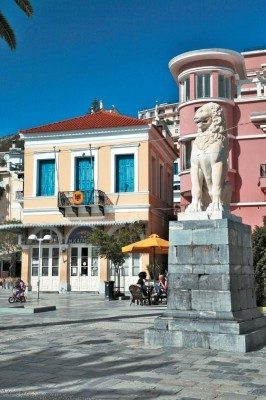 Finally, after all these discussions and debates, along with the 1821 Greek War of Independence centenary celebrations in Samos (took place on August 6, 1921), the National Independence Memorial (the Lion of Chaeronea) was also unveiled in celebration.
Finally, after all these discussions and debates, along with the 1821 Greek War of Independence centenary celebrations in Samos (took place on August 6, 1921), the National Independence Memorial (the Lion of Chaeronea) was also unveiled in celebration.
As already mentioned, the unveiling ceremony took place amidst great celebrations. Anchored at port, “Georgios Averof”, the Pisa-Class Armored Cruiser of the Royal Hellenic Navy, saluted the unveiling ceremony with cannonry, a music band playing the Greek national anthem, bells tolled, while Sofoulis delivered the official festive speech. Later, during the same day, officials went to Pytharoreion in order to participate in the unveiling ceremony of the Kavo-Fonias Column, in memory of the Battle of Mycale.
Who could ever imagine that the Lion of Pythagoras Square had such a story to tell or how it became a matter of controversy between the so-called “Venizelos-Supporters” and “Venizelos-Opponents” or between the “Lion-Advocates” and “Lion-Opponents”. Nevertheless, the Lion of Pythagoras Square is a memorial, which epitomizes courage, vigor, determination, and generosity.
The Lion as a symbol of Samos City
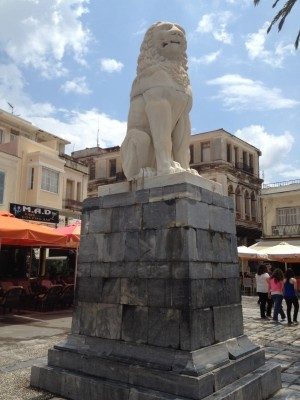 Among other things, the Lion symbolizes a sleepless guard, a city guardian, while it is seen as deterrent against any hostile aggression towards those who are guarded by the Lion (even in the present days, states or political authorities see and use lion as a symbol of strength and enforcement). In any case, over the years, the Lion of Pythagoras Square became an integral part of local identity. It’s not just a statue in the middle of a square. It is rather seen as a symbol of the entire city. It is also a symbol of Samos’s modern historical memory, which is stoked with new, but quite similar, historical symbolisms. It is a symbol of national resistance put forth by the people of Samos against the Nazi invaders, while the “wounds” it suffered during the 1943 bombing testify for the resistance of the people of Samos towards Nazism. It is a central point, a focal point, around which our diverse daily lives unfolding or where we perform all national holidays and celebrations. All these thinks are taking place under the “gaze” of the Lion.
Among other things, the Lion symbolizes a sleepless guard, a city guardian, while it is seen as deterrent against any hostile aggression towards those who are guarded by the Lion (even in the present days, states or political authorities see and use lion as a symbol of strength and enforcement). In any case, over the years, the Lion of Pythagoras Square became an integral part of local identity. It’s not just a statue in the middle of a square. It is rather seen as a symbol of the entire city. It is also a symbol of Samos’s modern historical memory, which is stoked with new, but quite similar, historical symbolisms. It is a symbol of national resistance put forth by the people of Samos against the Nazi invaders, while the “wounds” it suffered during the 1943 bombing testify for the resistance of the people of Samos towards Nazism. It is a central point, a focal point, around which our diverse daily lives unfolding or where we perform all national holidays and celebrations. All these thinks are taking place under the “gaze” of the Lion.
(Source: General State Archives, Samos Department, “The city of Samos: Physiognomy and evolution”, Conference records, Samian Studies, Volume V (2001-2002), “Samos: From Byzantine years to the present”, Conference record, Volume II.)
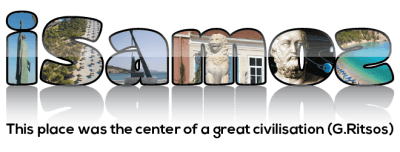 iSamos.gr Η ενημερωτική σελίδα της Σάμου! Εξερευνήστε τη Σάμο, τις παραλίες της, τη φύση της, τις ομορφιές της. Διαβάστε την ιστορία της Σάμου
iSamos.gr Η ενημερωτική σελίδα της Σάμου! Εξερευνήστε τη Σάμο, τις παραλίες της, τη φύση της, τις ομορφιές της. Διαβάστε την ιστορία της Σάμου

